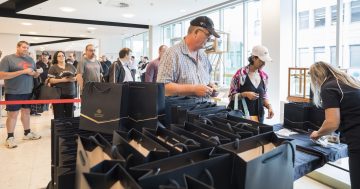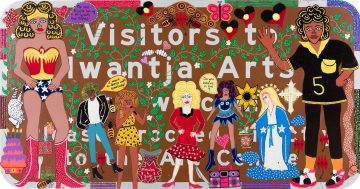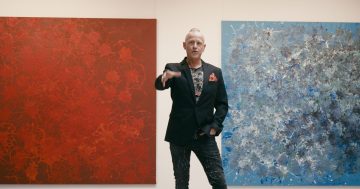Lydia Wang* breaks down what’s behind non-fungible tokens (NFTs).
 The singer Grimes made millions last year in an unusual way: by selling art and short videos as NFTs, also known as non-fungible tokens — and, she isn’t the only one.
The singer Grimes made millions last year in an unusual way: by selling art and short videos as NFTs, also known as non-fungible tokens — and, she isn’t the only one.
NFTs represent the rights to a digital work of art or other media — and some people think they’ll soon be more commonplace than bitcoin.
In fact, NFTs are already growing ubiquitous: Infamous influencer Logan Paul has made millions off them; rapper Azealia Banks sold a 25-minute audio sex tape for the equivalent of $18,000 (approx $25,000 AUD); and, Kings of Leon will become the first band to release an album in the form of an NFT.
In the latter case, with the purchase of the band’s NFT, owners can access special perks like tickets to future concerts, exclusive audiovisual art, and more.
But let’s back up.
What, exactly, are NFTs, what is the point of buying them, where can they be purchased, and why are we suddenly hearing about them so much?
As stated above, NFTs are digital tokens representing a work of art or media.
What they are not is cryptocurrency, because their value is not static or prone to only small fluctuations in value.
Instead, NFTs’ value can go up and down, depending on demand.
In that way, buying an NFT is like buying an actual work of art: Demand dictates worth, and is subject to the whims of the market, no matter how extreme.
(In this way, NFTs are also a little like stocks.)
NFTs can be purchased through online marketplaces like OpenSea, which artists use to mint their work.
Once minted, these works are published into tokens, and from there, buyers can either purchase the NFTs or bid on them with cryptocurrency.
But, unlike purchasing a physical painting, say, when you buy an NFT, you are obtaining the rights to a digital asset, not the actual asset.
To put it another way, one cryptoartist told me that this article could even be minted into an NFT; if someone bought it, they wouldn’t be buying the literal article, but the digital asset of it.
“The underlying thing that you’re buying is code that manifests as images,” Donna Redel, a professor of crypto-digital assets at Fordham Law School, told NPR.
One common question about NFTs related to whether or not, since all you have are the rights to an item and not the item itself, you could get ripped off.
But, while someone else could conceivably download or print the same work of art, there’s a record of your ownership.
And because these tokens are on a decentralized database (the Ethereum blockchain), that record is public, also minimizing the possibility of fraud or theft and letting potential buyers verify authenticity.
Another appeal of NFTs is the creative element — something you just don’t get with cryptocurrencies.
Although some NFT collectors are cryptocurrency enthusiasts, others just enjoy owning artwork (or they’re fans of people like Grimes and Azealia Banks, maybe); many have likened NFTs to trading cards or collectible items.
Artist Silje Thorn, who first discovered NFTs last summer, tells Refinery29 that many buyers aren’t new to paying for digital items, “particularly from video games, where you often pay real money for things like in-game items, outfits, and accessories.” The pivot to spending money on cryptoart, Silje explains, isn’t a dramatic one.
And there are several reasons that creators are drawn to the world of NFTs.
Sarah Zucker, who works across mediums and specializes in screen-based artwork, was excited about the possibility to edition and value her work the same way other, more “traditional” artists have always been able to.
She minted her first NFT in 2019.
“To have your work be viewed and discussed as something real and tangible has psychic and emotional benefits beyond the obvious life-changing aspect of being able to support yourself directly from your work,” Zucker tells Refinery29.
As artist Cat Russell puts it, NFTs give creators “a method to showcase and sell [their work] without jumping through the logistics of making prints.” Through decentralized platforms like OpenSea, artists aren’t only able to reach a large, diverse, international community of buyers: they’re able to directly sell their work and have control over their own product.
In Cat’s words, this system cuts out the middleman.
Creators can also continue to collect royalties as their tokens are resold, which digital artists say is revolutionary.
“It’s incredibly hard making a living as an artist, especially for digital artists, who aren’t able to charge as much as artists selling physical work that can’t be duplicated like digital art can,” Silje tells Refinery29.
“And on top of that, even for artists who create physical work, the art world is so exclusive that most won’t get far, either because they don’t have the right contacts or because they’re at a geographical disadvantage.”
The most common criticism of NFTs is one levelled at about other forms of cryptocurrency.
Because computers have to verify transactions within a complex cryptocurrency network to “mine” bitcoin, the transactions use a lot of energy, which has a stark impact on the environment — some researchers with Cambridge University say that bitcoin’s carbon footprint is bigger than the Netherlands’ annual energy consumption.
However, there are reportedly cryptocurrency enthusiasts who are working on fixing the problem.
Several cryptoartists also told me that the community is aware of Ethereum’s environmental impact.
“Artists are also upset by the inefficiency of the system, and are trying to push for it to be less harmful, putting pressure on developers and forcing participants to think of alternative solutions,” cryptoartist DaniellaDoodles says.
There’s also the critique that cryptocurrency is merely a hobby for Silicon Valley bros, but this is another perception that cryptoartists want to fix.
Silje is a member of Women of Crypto Art, a group that aims to help women earn more from NFT sales, address gender disparities, and provide a supportive space for women artists.
Investors, digital artists, and producers like Steve Aoki, believe that NFTs could be the future.
“NFTs allow digital artworks to have the same quality of scarcity that gives physical artworks their value, while allowing them to retain infinite visibility in their native format,” Zucker says.
“This is as simple as it is game-changing.”
And then there are the people who simply don’t understand, for example, why an NFT by an artist named Beeple sold for $69 million (approx $94,651440 million AUD).
But Zucker says that the people who are drawn to NFTs — for whatever reason — are touched by it in different ways.
“As I see it, especially after the past year of the pandemic, we live increasingly in the digital world,” Zucker says.
“So it stands to reason that we are developing systems of value around the aesthetic and creative elements that populate that world.”
*Lydia Wang is a contributor at Refinery29.
This article first appeared at refinery29.com.











